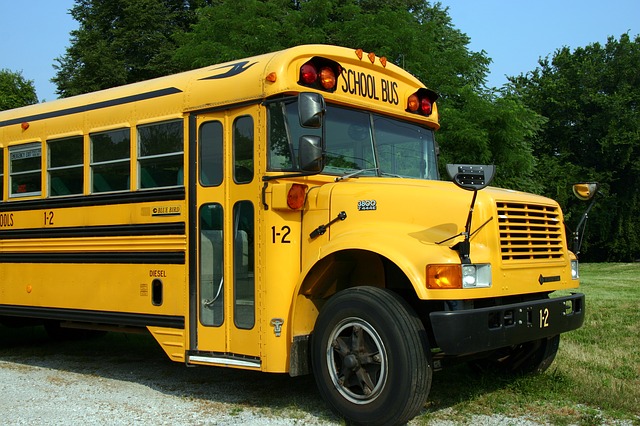
Image Credit: macdeedle / Pixabay
Do Illinois Schools Have to Provide School Bus Transportation?
Per the Illinois Vehicle Code, only certain types of school districts are required by law to provide free transportation services to students. Combined districts are required to provide free transport to pupils who reside one-and-a-half miles from any school to which they are assigned within the district. In most states, there might need to be arrangements for pick-up locations for children that live more than two miles from the district and that reside down roads that are not school bus accessible.
Do Illinois School Buses Have Cameras?
Since 2012, there have been motions that were approved to allow school buses to place stop-cameras on the bus that will capture drivers passing stopped buses illegally. Illinois has had these cameras installed on school buses since 2013. This decision was motivated by the 2,114 vehicles that were recorded in a single day passing school buses illegally.
When Can You Not Pass a School Bus in Illinois?
In Illinois, you will always have to stop behind a school bus that has the stop sign and warning lights on. You will also have to stop if you are in oncoming traffic when these warning lights and the sign are on and present. This applies to multi-lane roads as well as single-lane roads. The traffic must stop until the school bus driver turns off the lights and brings in the swing arm stop sign.
What License do you Need to Drive a School Bus in Illinois?
You will need a CDL to drive a school bus in Illinois and you will have to have the “P” passenger and “S” school bus endorsements on your license. You will also have to have the “SBP” school bus permit indicator from the state of Illinois for your school bus permit, along with other requirements. The school bus endorsement will be added to your license when you are certified to drive a school bus in the state of Illinois.
Can a School Bus Driver in Illinois Continue to Pick Up Students if the Stop Arm Malfunctions?
A school bus driver can continue to drop off and pick up children in accordance with local board guidance if this part of the bus is broken, but they must keep a record of when the malfunction first occurs. If the malfunction is discovered during the pre-trip inspection, the school bus should not be used. Warning lights and a stopped school bus indicate to drivers that this is the process that is going on, even if the swing arm is not showing or working. Drivers are still held to the same laws and responsibilities even if the swing arm is not working, and bus drivers should still ensure that students are able to safely exit or enter the bus.
Can Felons Be Licensed to Drive School Buses in Illinois?
Those convicted of certain offenses are prohibited from driving school buses, which is why applicants must submit their fingerprints to the Department of State Police. School districts cannot accurately check a person’s possible criminal record if they do not compare fingerprints. This is part of the hiring process and there should be no risk that a felon will be allowed to drive a school bus in Illinois.
What Is the Danger Zone Near a School Bus?
The danger zone of a school bus is in the area that is ten feet ahead of and behind the school bus, and up to 30 feet. The most dangerous place near a school bus is by the front bumper near the front right tire. Children and drivers need to be educated about the risk of being unable to see anyone who is obscured by the sides of the bus or on the backside of the bus away from traffic.
Are Seat Belts Required on Illinois School Buses?
At this time, seat belts are not required on school buses in Illinois. The states that do require that seat belts be present on buses are Arkansas, California, Florida, Louisiana, Nevada, New Jersey, New York, and Texas. All other states do not require that seatbelts be present on buses but they may have buses in their fleet that do have seatbelts.
Why Do School Buses Have the Three Black Lines on the Side?
The three black lines that are on the sides of a school bus are rub rails. They are there for the protection of the school bus in the case of a collision. The walls of a school bus are thin in this location and these rub rails are meant to reinforce the school bus in the case of collision. These rails are meant to protect school buses from caving in at the sides in an accident.
What Is the Approximate Length of a School Bus?
School buses in the U.S. range from 20 to 45 feet in length. Buses that are 20–25 feet long are considered minibuses. Buses that are over 35 feet are considered full-sized. Most buses in the U.S. will be in the 25–35-foot length category.
What Do Yellow Lights on a School Bus Mean?
Motorists must remain stopped so long as the red lights on the bus are flashing. Some school buses will flash yellow lights as they are slowing down to drop off and pick up kids and then turn on red lights when they are completely stopped and the stop sign has been deployed. The yellow lights are meant as a warning to motorists around the bus to slow down.
Can You Pass a School Bus if the Stop Sign is Not Out?
You cannot pass the school bus when the stop sign is not out unless the lights are also turned off and the driver has begun driving again. You might also be able to pass a school bus if the driver signals you to go ahead and pass. You should still always drive slowly and look for children before you drive forward. Sometimes children will not proceed onto the sidewalk as expected and could run out into the road.
How Wide Is a School Bus Seat?
A school bus seat is about 39 inches wide on average. The aisle might be 18–45 inches in width depending on the size of the seats on the interior of the bus. The wider the seats, the narrower the aisle between them. Children are normally asked to sit two at a time on school bus seats.



